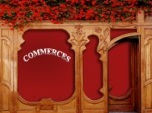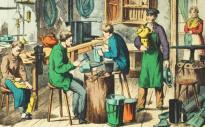L' histoire de Metz et de la Lorraine, histoire de la moselle - cartes postales anciennes de Metz - cartes postales anciennes de Moselle - histoire Moselle

Maison N°2, Rue Taison
Mr Robert DUPUIS, a boilermaker by his trade, practised his art at number 2, rue Taison, in 1809.
Nowadays, boilermakers work in factories, making huge boilers for steam engines, big-sized containers for distilleries, breweries, sugar refineries, metal reservoirs and pipes; the most part of the work is done with a machine, and the worker hardly takes part to it by setting up a piece or refining the work of the machine, which is still sometimes rough.
In the old days, on the contrary, boilermakers used to work only with their hands, they were often artists, who made only copper utensils for domestic use, or important pieces dedicated to worship, such as lecterns and baptismal fonts, or candelabra.
In Dinant, until the city was taken and destroyed by Charles the Bold in 1466, boilermakers used to make essentially cleaning utensils, coquemars (sorts of huge pitchers), ewers, men- or animals-face-shaped torches, basins, mortars, etc. The glory this kind of works had brought to Dinant was so well established, that the boilermakers were often called dinandiers; sometimes, they were also named maignans, from an old French word magnien, meaning caldron.
In this trade, just like in many others in the Middle Ages, there were an aristocracy of great makers and a disdained class of poor workers; the first were the actual boilermakers who, remaining in their workshops, made all the nice items; the others were called chaudronniers au sifflet (whistle-carrying boilermakers): they did not have the right to work in cities where boilermakers were organised in communities. Whistling in a pan
flute, hence their name, they crossed towns, carrying all their paraphernalia in a bag on their back; they were in for tinning, repairing, and also, sometimes, selling old copper items.
Beside the boiler making, which shapes only bronze or copper, the tinplate industry grew, in the modern times. It consists in making items out of thin iron leaves soaked into molten tin. This is a recent industry; the manufacturing process is claimed to have been invented in Bohemia, at the end of the 15th century. Colbert went to a fair amount of effort to bring it to France; he entrusted this mission to the abbot de Gravel, who represented the French King in Germany: his role was to corrupt some German workers and take them to France. The abbot succeeded and, in Beaumont, in the Nivernais, these workers founded our first tinware factory.
Since then, this industry prospered; the activity has much increased today, consequently to the growth of the production of conserves, fish, meat, vegetables, etc., which are then boxed in tin cans.



